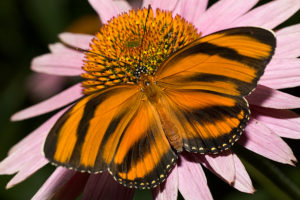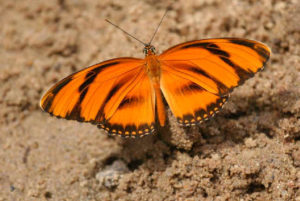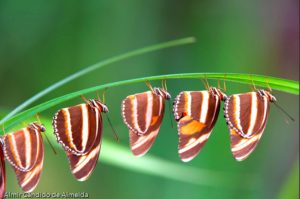A very stunning butterfly is the Banded Orange Heliconian (Dryadula phaetusa) also known as the Orange Tiger.
It can be found from Mexico to northern Argentina, and in summer can be found on rare occasions as far north as central Florida.

The vertical lines on the wings are an example of disruptive patterning. This breaks up the outline of the butterfly to make it difficult for birds and other predators to see and catch it.

This butterfly displays many interesting behaviors. It not only feeds on the nectar of flowers, the males sip nutrients from wet sand and mud and bird droppings. This behavior is called mud-puddling. From the fluids they obtain nutrients such as salts and amino acids needed for successful mating.


Males are very territorial and will find a place to perch near the host plant, Passionvine (passiflora spp.), where they can watch for females. They patrol around the area in search of females. Once a potential mate is spotted, the male will flutter around the female in a figure-eight motion before settling beside her. If she is receptive she remains motionless, and the male then half opens his wings. He then flutters them very rapidly for a few seconds to direct his pheromones towards her antennae, which has the effect of placating her. The male then curves his abdomen around to make contact and copulate.
Just like many Heliconius species, the butterflies will find a bush or tree where they can rest for the night. They tend to find the same place every day around dusk to settle down in clusters to roost overnight.


